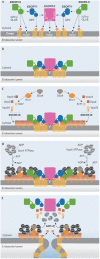A concentric circle model of multivesicular body cargo sorting
- PMID: 17603537
- PMCID: PMC1905901
- DOI: 10.1038/sj.embor.7401004
A concentric circle model of multivesicular body cargo sorting
Abstract
Targeting of ubiquitylated transmembrane proteins into luminal vesicles of endosomal multivesicular bodies (MVBs) depends on their recognition by endosomal sorting complexes required for transport (ESCRTs), which are also required for MVB vesicle formation. The model originally proposed for how ESCRTs function succinctly summarizes much of the protein-protein interaction and genetic data but oversimplifies the coordination of cargo recognition and cannot explain why ESCRTs are required for the budding of MVB vesicles. Recent structural and functional studies of ESCRT complexes suggest an alternative model that might direct the next series of breakthroughs in understanding protein sorting through the MVB pathway.
Figures







Similar articles
-
Endosomal and non-endosomal functions of ESCRT proteins.Trends Cell Biol. 2006 Jun;16(6):317-26. doi: 10.1016/j.tcb.2006.04.004. Epub 2006 May 22. Trends Cell Biol. 2006. PMID: 16716591 Review.
-
ESCRT ubiquitin-binding domains function cooperatively during MVB cargo sorting.J Cell Biol. 2009 Apr 20;185(2):213-24. doi: 10.1083/jcb.200811130. J Cell Biol. 2009. PMID: 19380877 Free PMC article.
-
Did2 coordinates Vps4-mediated dissociation of ESCRT-III from endosomes.J Cell Biol. 2006 Dec 4;175(5):715-20. doi: 10.1083/jcb.200606113. Epub 2006 Nov 27. J Cell Biol. 2006. PMID: 17130288 Free PMC article.
-
The emerging shape of the ESCRT machinery.Nat Rev Mol Cell Biol. 2007 May;8(5):355-68. doi: 10.1038/nrm2162. Nat Rev Mol Cell Biol. 2007. PMID: 17450176 Review.
-
A protein's final ESCRT.Traffic. 2005 Jan;6(1):2-9. doi: 10.1111/j.1600-0854.2004.00246.x. Traffic. 2005. PMID: 15569240 Review.
Cited by
-
In vitro budding of intralumenal vesicles into late endosomes is regulated by Alix and Tsg101.Mol Biol Cell. 2008 Nov;19(11):4942-55. doi: 10.1091/mbc.e08-03-0239. Epub 2008 Sep 3. Mol Biol Cell. 2008. PMID: 18768755 Free PMC article.
-
The Arabidopsis ESCRT protein-protein interaction network.Plant Mol Biol. 2011 May;76(1-2):85-96. doi: 10.1007/s11103-011-9770-4. Epub 2011 Mar 26. Plant Mol Biol. 2011. PMID: 21442383
-
ESCRT-III-Associated Protein ALIX Mediates High-Affinity Phosphate Transporter Trafficking to Maintain Phosphate Homeostasis in Arabidopsis.Plant Cell. 2015 Sep;27(9):2560-81. doi: 10.1105/tpc.15.00393. Epub 2015 Sep 4. Plant Cell. 2015. PMID: 26342016 Free PMC article.
-
Arabidopsis ALIX Regulates Stomatal Aperture and Turnover of Abscisic Acid Receptors.Plant Cell. 2019 Oct;31(10):2411-2429. doi: 10.1105/tpc.19.00399. Epub 2019 Jul 30. Plant Cell. 2019. PMID: 31363038 Free PMC article.
-
Genome-wide analysis reveals the vacuolar pH-stat of Saccharomyces cerevisiae.PLoS One. 2011 Mar 14;6(3):e17619. doi: 10.1371/journal.pone.0017619. PLoS One. 2011. PMID: 21423800 Free PMC article.
References
-
- Babst M (2005) A protein's final ESCRT. Traffic 6: 2–9 - PubMed
-
- Babst M, Katzmann DJ, Estepa-Sabal EJ, Meerloo T, Emr SD (2002a) ESCRT-III: an endosome-associated heterooligomeric protein complex required for MVB sorting. Dev Cell 3: 271–282 - PubMed
-
- Babst M, Katzmann DJ, Snyder WB, Wendland B, Emr SD (2002b) Endosome-associated complex, ESCRT-II, recruits transport machinery for protein sorting at the multivesicular body. Dev Cell 3: 283–289 - PubMed
Publication types
MeSH terms
Substances
Grants and funding
LinkOut - more resources
Full Text Sources

